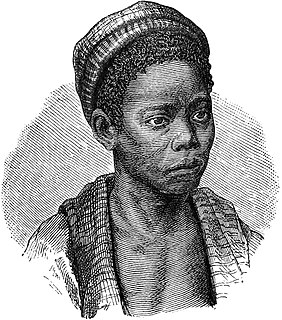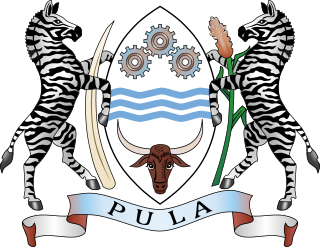| |||||
| Decades: | |||||
|---|---|---|---|---|---|
| See also: | |||||
The following lists events that happened during 1982 in Botswana .
| |||||
| Decades: | |||||
|---|---|---|---|---|---|
| See also: | |||||
The following lists events that happened during 1982 in Botswana .

Botswana, officially the Republic of Botswana ; is a landlocked country in Southern Africa. Botswana is topographically flat, with up to 70 percent of its territory being the Kalahari Desert. It is bordered by South Africa to the south and southeast, Namibia to the west and north, and Zimbabwe to the north-east. It is connected to Zambia across the short Zambezi River border by the Kazungula Bridge.
The Batswana, a term also used to denote all citizens of Botswana, refers to the country's major ethnic group. Prior to European contact, the Batswana lived as herders and farmers under tribal rule.

The Tswana are a Bantu-speaking ethnic group who are native to Southern Africa. The Tswana language is a principal member of the Sotho-Tswana language group. Ethnic Tswana made up approximately 85% of the population of Botswana in 2011.

Botswana is an African country made up of different ethnic groups, although Batswana are the majority of the population. Music is a large part of Botswana culture, and includes popular and folk forms. Botswana church choirs are common nationwide.
The University of Botswana, popularly known as UB, was established in 1982 as the first institution of higher education in Botswana. The university has three campuses: one in the capital city Gaborone, one in Francistown, and another in Maun. The university is divided into six faculties: Business, Education, Engineering, Humanities, Science and Social Sciences and the University of Botswana School of Medicine, a collaboration with the University of Melbourne in Australia.

Elections in Botswana take place within the framework of a multi-party democracy and a parliamentary system. The National Assembly is mostly directly elected, and in turn elects the President and some of its own members. The Ntlo ya Dikgosi is a mixture of appointed, hereditary and indirectly elected members.

The cuisine of Botswana is unique but shares some characteristics with other cuisines of Southern Africa. Examples of Setswana food include pap, samp, vetkoek, bogobe and mophane worms. A food unique to Botswana is seswaa, salted mashed-up meat.

Besides referring to the language of the dominant people groups in Botswana, Setswana is the adjective used to describe the rich cultural traditions of the Batswana - whether construed as members of the Setswana ethnic groups or of all citizens of Botswana. the Batswana believe in the rich culture of Botho-Ubuntu, ‘‘People are not individuals, living in a state of independence, but part of a community, living in relationships and interdependence.’ Batswana believe in working together and in being united. There are different ethnic groups in the Tswana tribe among them the Barolong, Bakwena, Bakgatla, Baphuthing, Bataung, Bangwaketse, Batawana, Bahurutshe,Balete, Bakalanga, Bayei, Bambukushu, Baubiya, Basarwa, Baherero,Bakgothu, Batswapong and Batshweneng. All these tribes believe in different customs but are still guided by the Tswana culture and way which makes them have similarities. The languages are still the same but differ slightly from one area to the other or by dialects but they are all regarded as Setswana. The Batswana are based in the Northwest Province of the Republic of South Africa and Botswana.

The Sotho-Tswana peoples are a meta-ethnicity of southern Africa and live predominantly in Botswana, South Africa and Lesotho. The group mainly consists of four clasters; Southern Sotho (Sotho), Northern Sotho and Western Sotho. The last group is sometimes referred to as the Eastern Sotho and consists of the Pulana, Makgolokwe/Bakholokoe the Pai and others.
Botswana Telecommunications Corporation (BTC) is a telecommunications and Internet service provider in Botswana, and is headquartered in Gaborone. It provides telecommunications services throughout the country.
Keoagetse Radipotsane is a Batswana football midfielder currently playing for Notwane FC. He is a member of the Botswana national football team.

The following outline is provided as an overview of and topical guide to Botswana:
The National Library Service of Botswana is the legal deposit and copyright library for Botswana. It was officially opened on April 8, 1968. They strive to be a world class library and information hub. The library is considered one of the most centralized in the world, as it is responsible for the professional development for all libraries within Botswana, including academic ones.

A referendum on judicial reform was held in Botswana on 3 November 2001, having been originally scheduled for 6 October, but later postponed. The referendum asked eight separate questions about judges and courts, all of which were approved, seven by a margin of over 70%. Voter turnout for the referendum was just 4.9%, with 22,600 votes from a total of 460,252 registered voters. The postponement of the referendum by the government, a legal challenge by the Tswana nationalist group Pitso Ya Batswana, and a call by the group for a boycott were all suggested as reasons for the low turnout. Pitso Ya Batswana claimed that the referendum was an attempt by the BaKalanga ethnic group, who are over-represented in the judicial system, to increase their hold over it.
The history of Gaborone began with archaeological evidence in the area around Gaborone dating back to 400 BCE, and the first written accounts of Gaborone are from the earliest European settlers in the 19th century. Since the 1960s, when Botswana gained its independence from Britain and Gaborone became the capital, the city has grown from a small village in the Botswana scrubland to a major center in southern Africa.
Stanley Tshoshane is a Batswana football manager.
The Battle of Dimawe was fought between several Batswana tribes and the Boers in August 1852. Under the command of Kgosi Setshele I of the Bakwena tribe, the Batswana were victorious at Dimawe Hill.

The Manyana Rock Paintings are a collection of rock art and caves located at the Kolobeng hills, neighbouring Manyana, Southern District, Botswana. It is believed that the artworks were made by the Khoikhoi or the San people between 1100 AD and 1700 AD. The paintings are found on five cliff areas around the rocky hill. Today, the site is fenced and protected as a National Monument.
Morwalela Seema is a Motswana former footballer who played as a striker for Mahalapye-based club Queens Park Rangers, Township Rollers and the Botswana national football team. He retired from professional football in 1984 as one of the best Batswana to ever grace the game.

Batswana nationality law is regulated by the 1966 Constitution of Botswana, as amended; the Citizenship Act 1998, and its revisions; and international agreements entered into by the government of Botswana. These laws determine who is, or is eligible to be, a national of Botswana. The legal means to acquire nationality, formal legal membership in a nation, differ from the domestic relationship of rights and obligations between a national and the nation, known as citizenship.The Botswana nationality is typically obtained on the principle of jus sanguinis, i.e. by birth to parents with Botswana nationality. It can be granted to persons who have lived in the country for a specific period of time, who have performed distinguished service to the nation or who have an affiliation to the country through naturalisation.